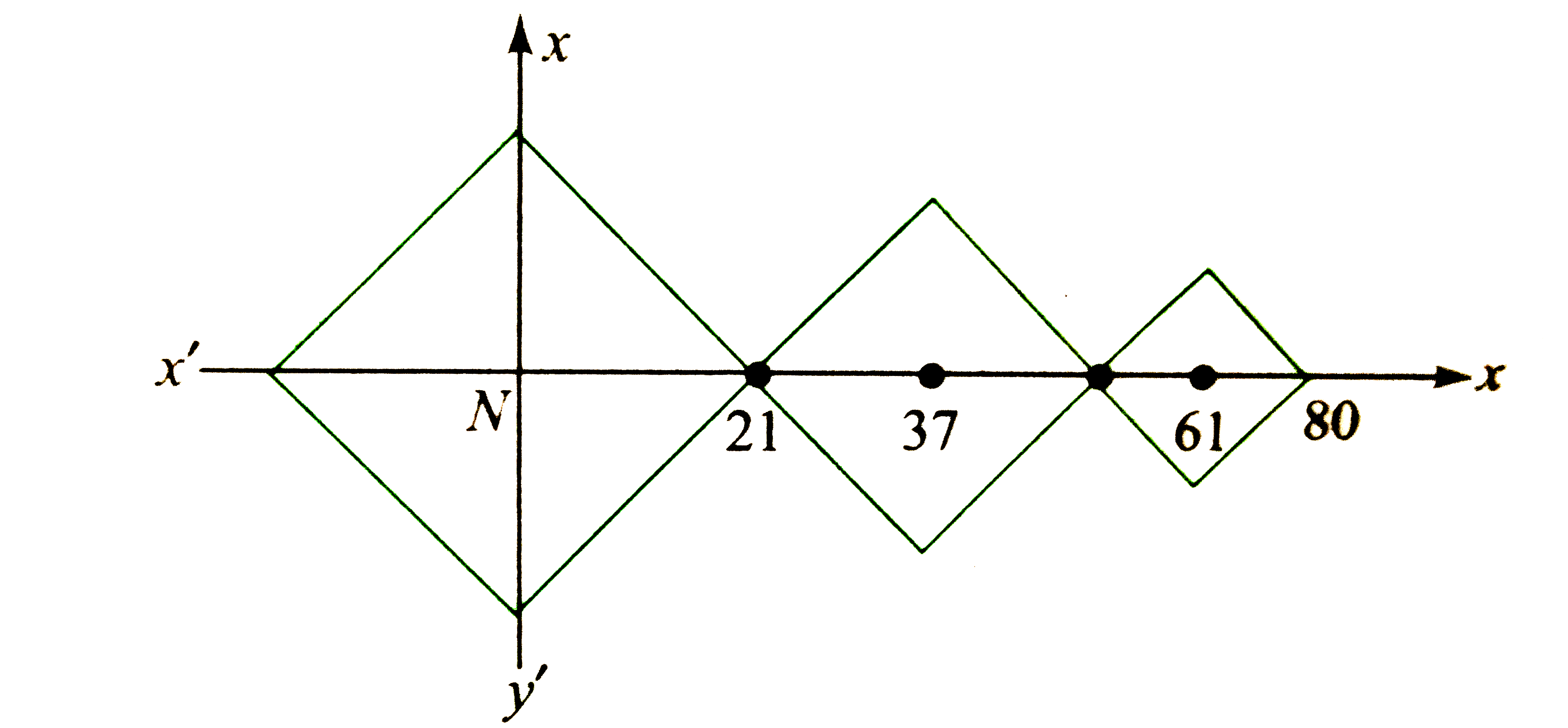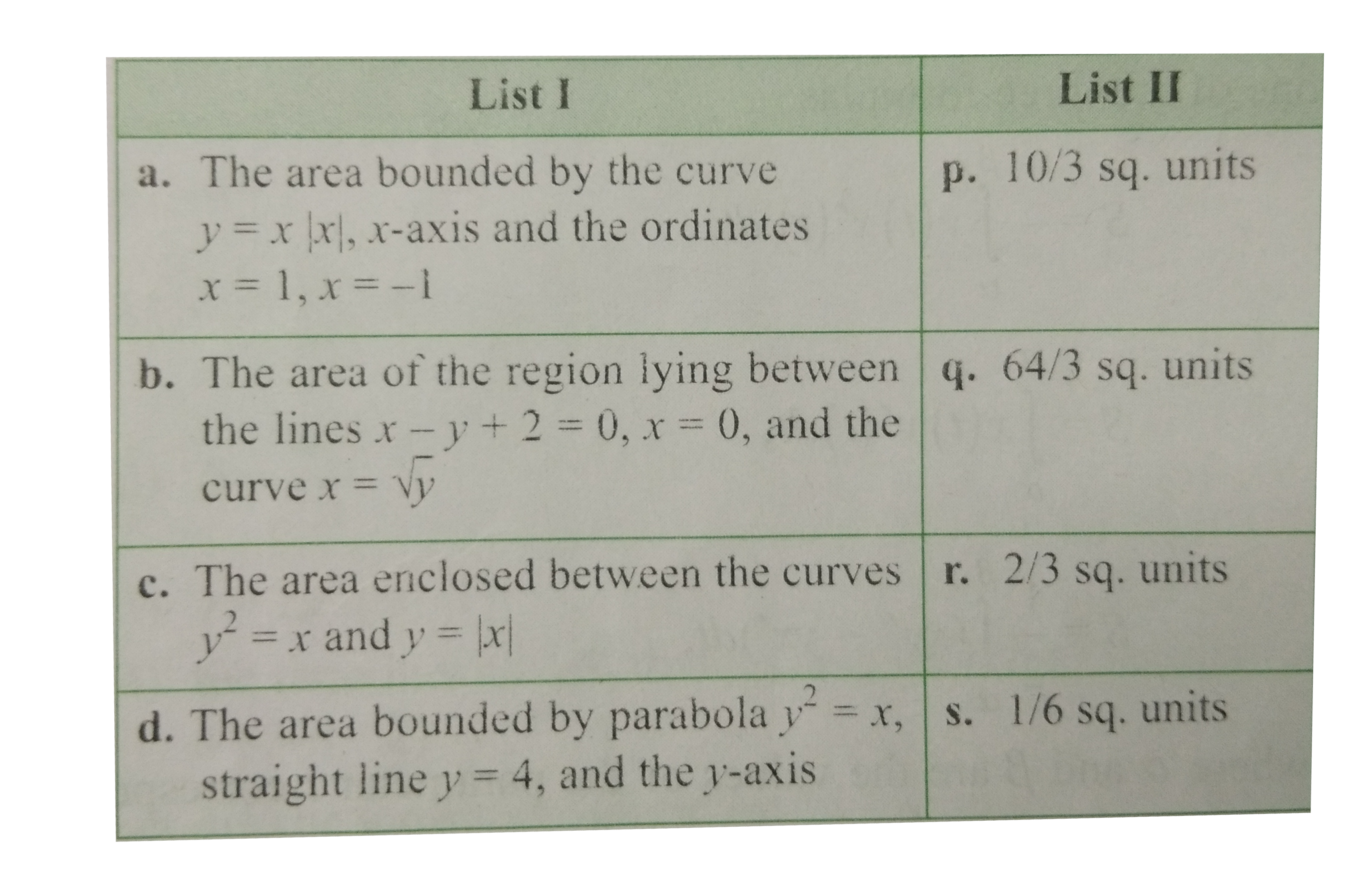If Ai is the area area bounded by |x−ai|+|y|=bi,i∈N ,where ai+1=ai+32biandbi+1=bi2,a1=0andb1=32, thenSolution in Bengali
A. A3=128
B. A3=256
C. limn→∞nΣi=1Ai=83(32)2
D. limn→∞nΣi=1Ai=43(16)2
The correct Answer is:A, C
a1=0,b1=32,a2=a1+32b1=48,b2=b12=16
a3=48+32×16=72,b3=162=8

So the three loops from i=1 to i=3 are alike.
Now area of ith loop (square) =12(diagonal)2
Ai=12(2bi)2=2(bi)2
So,Ai+1Ai=2(bi+1)22(bi)2=14.
So the areas from a G.P. series.
So, the sum of the G.P. up to infinite terms is
A111−r=2(32)2×11−14
=2×(32)2×43=783(32)2 sq. units.
Topper's Solved these Questions
- BOOK - CENGAGE PUBLICATIONCHAPTER - AREAEXERCISE - Linkded Comprehension Type21videos
AREA
- BOOK - CENGAGE PUBLICATIONCHAPTER - AREAEXERCISE - Matrix Match Type5videos
AREA
- BOOK - CENGAGE PUBLICATIONCHAPTER - AREAEXERCISE - Exercises - Single Correct Answer Type40videos
AREA
- BOOK - CENGAGE PUBLICATIONCHAPTER - APPLICATIONS OF DERIVATIVESEXERCISE - Subjective Type2videos
APPLICATIONS OF DERIVATIVES
- BOOK - CENGAGE PUBLICATIONCHAPTER - BINOMIAL THEOREMEXERCISE - Comprehension11videos
BINOMIAL THEOREM
Similar Questions
Let Ar be the area of the region bounded between the curves y2=(e−kr)x(where k>0,r∈N) and the line y=mx(where m≠0), k and m are some constants
A1,A2,A3,… are in G.P. with common ratio03:34View SolutionMatch the following lists :
 07:19View Solution
07:19View SolutionArea enclosed by the curve y=f(x) defined parametrically as x=1−t21+t2,y=2t1+t2isequa<o πsq.units (b) π2sq.units 3π4sq.units (d) 3π2sq.units
View SolutionProve that for λ>1, the equation xlogx+x=λ has least one solution in [1,λ].
04:07View SolutionConsider a G.P. with first term (1+x)n, |x|<1, common ratio 1+x2 and number of terms (n+1). Let 'S' be sum of all the terms of the G.P., then
The coefficient of xn is 'S' isView SolutionLet a_i^2+b_i^2+c_i^2=1 (for i=1,2,3) and a_ia_j+b_ib_j+c_ic_j=0 (i != j;i,j=1,2,3). Then the absolute value of determinant |(a_1,a_2,a_3),(b_1,b_2,b_3),(c_1,c_2,c_3)| (A) 1/2 (B) 0 (C) 1 (D) 2
02:38View Solution|(a_1-b_1+x,a_1-b_2,a_1-b_3),(a_2-b_1,a_2-b_2+x,a_2-b_3),(a_3-b_1,a_3-b_2,a_3-b_3+x)| =x^3+x^2sum_(i=l)^3(a_i-b_i)+xsum_(l lt=i < j <= 3)^3 (a_i-b_i)+x sum_(l <= i < j <= 3)(a_i-b_j)(b_i-b_j).
06:26View SolutionIf bi=1−aina=Σni=1ai,nb=Σni=1bi then Σni=1ab_i+Σni=1(ai−a)2=
05:27View SolutionGiven Σ20i=1ai=100,Σ20i−1a2i=600,Σ20i−1bi=140,Σ20i−1b2i=1000, where ai,bi denotes length and weight of an observations. Then which is more varying ?
03:30View Solutiona1,a2,a3 ,…., an from an A.P. Then the sum 10∑i=1aiai+1ai+2ai+ai+2 where a1=1 and a2=2 is :
02:40View SolutionStatement -1 : The lines aix+biy+ci=0,i={1,2,3} are concurrent if ∣∣ ∣∣a1b1c1a2b2c2a3b3c3∣∣ ∣∣=0
because
Statement -2 : The area of triangle fomed by three concurrent lines must be zero.03:33View SolutionThe circle orthogonal to the three circles x2+y2+aix+biy+c=0, (i=1,2,3) is
04:16View SolutionIf bi=1−ai,na=n∑i=1ai,nb=n∑i=1bi,thenn∑i=1ai,bi+n∑i=1(ai−a)2= ab b. nab c. (n+1)ab d. nab
02:20View SolutionIf A1 is the area area bounded by |x−ai|+|y|=bi,i∈N ,where ai+1=ai+32biandbi+1=bi2,ai=0andbi=32, then
04:57View SolutionIf f(x)=Π3i=1(x−ai)+∑i=1_3ai−3x where ai<ai+1 for i = 1,2, then f(x) = 0 have
05:56View SolutionIf f(x)=Π3i=1(x−ai)+∑i=1_3ai−3x where ai<ai+1 for i = 1,2, then f(x) = 0 have
05:07View Solution

